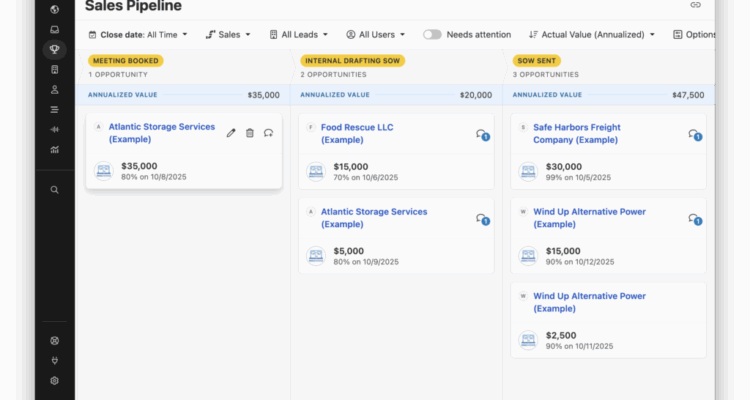If you’re running a sales team, the hunt for the right CRM for your Mac can feel endless.
Many CRMs are either bloated with marketing features you’ll never use or are focused on Windows users.
Close CRM positions itself slightly differently: a sales-first CRM built to keep reps calling, emailing, and closing deals faster, without getting bogged down in admin.
Unlike many CRMs, it also has a Mac desktop app proving that it hasn’t forgotten about users on macOS.
In this Close CRM review, we’ll cover how it works on a Mac, its key pros and cons, and if it’s the best CRM software for Mac for your business.
Table of Contents
What Is Close CRM?
Close is a cloud-based CRM that focuses on sales productivity.
Instead of trying to be an all-in-one CRM & email-marketing suite like tools such as HubSpot, Close builds around one central idea: your sales reps should spend more time talking to prospects and less time updating spreadsheets.
It’s best known for:
- Built-in calling, email, and SMS (so reps don’t need to switch apps).
- Clean, fast interface that keeps all activity on one screen.
- Automations that remove repetitive tasks like follow-up reminders (although many of these are limited in lower tiered plans).
Close has a native Mac desktop app as well as a browser version, so you’re not stuck with Windows-only tools.
Quick Facts About Close
- Pricing: Starts at $9/month for the Solo Plan. For teams, $35/user/month for the Essential Plan (annual billing). Growth Plan ($99) and Scale Plan ($139) tiers add more automation and reporting. Custom tiers for 10+ users are available.
- Best for: Small to mid-sized sales teams (2–50 reps) that need speed and efficiency.
- Integrations: Gmail, Google Calendar, Zoom, Calendly, HubSpot, Zapier, plus an API.
- Security: SOC 2 Type II, GDPR controls, encryption in transit and at rest.
- Mac compatibility: Native desktop app + works well in Safari or Chrome.
Getting Started With Close
You first need to sign-up for a free trial of Close and then you can download the Mac desktop app.
You can connect your existing mailbox to Close so that everything is synced with it.
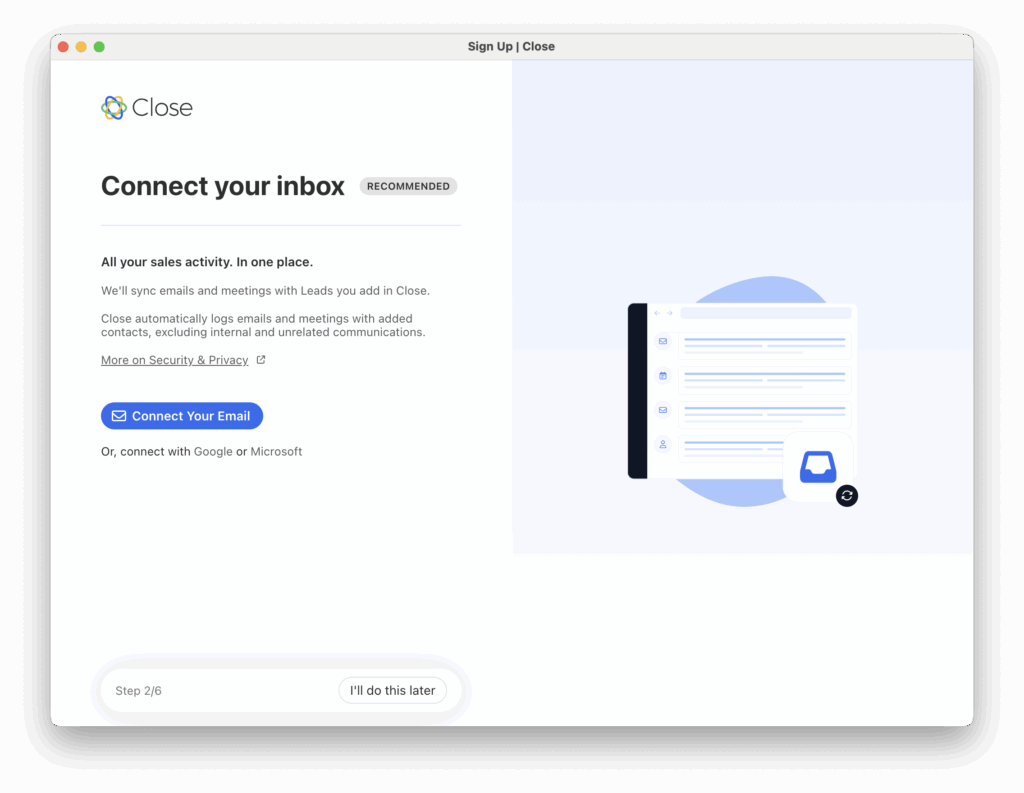
You’ll be asked a few questions about your identity, company role, what you plan to use Close for and how you currently manage your contacts.
Finally, you’ll be given the option to invite team members into Close CRM with you.
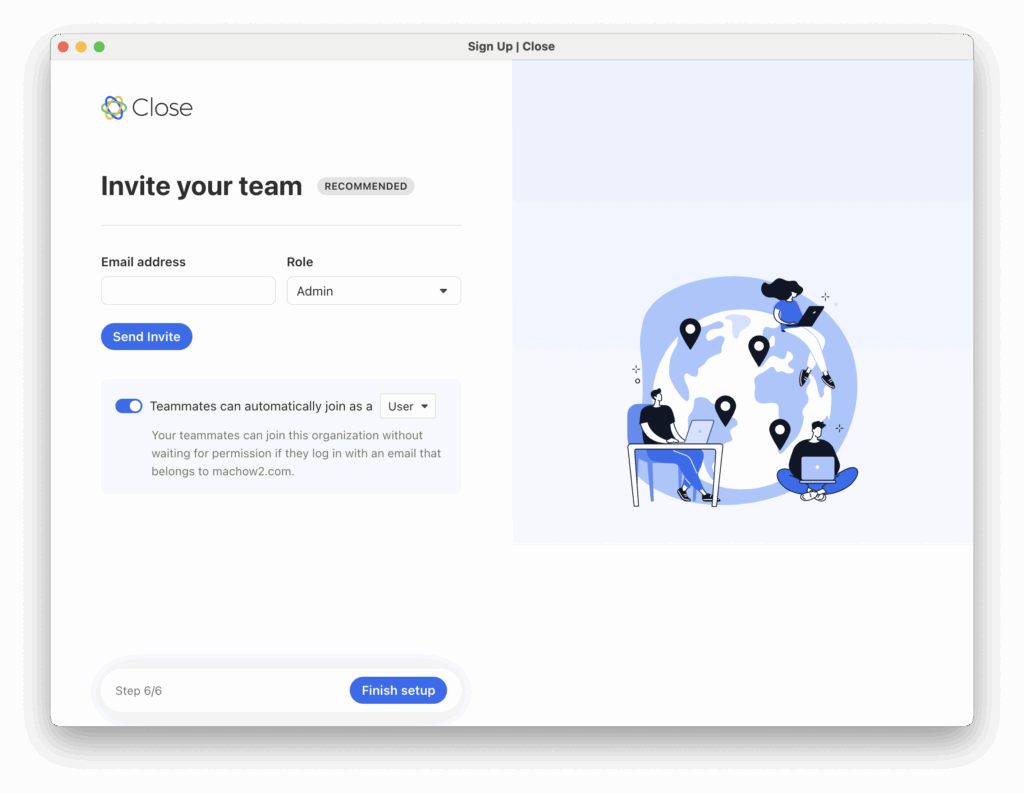
Once you get into the main interface, you’ll probably want to import your contacts which you can do either via CSV file, Excel or directly from most major CRMs.
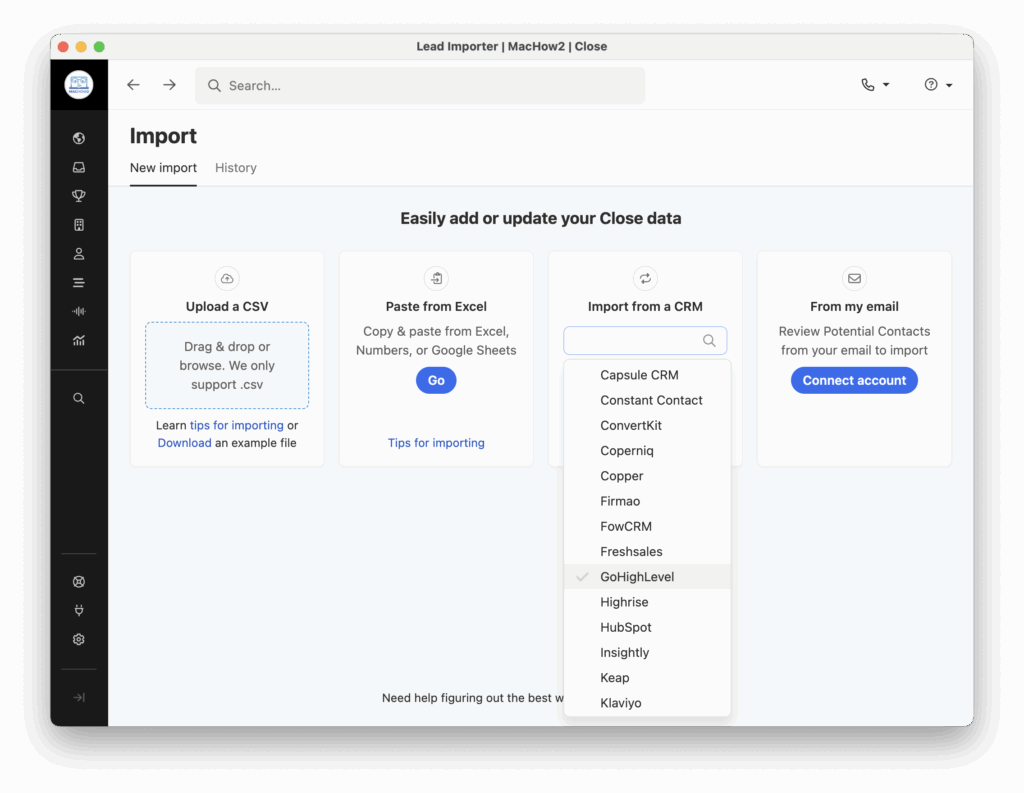
Along the left hand side is a navigation bar that takes you to your Inbox, Sales Pipeline, Leads, Contacts, Workflows, Conversations (including audio recordings as long as you give Close access to your microphone) and Reports.
One nice touch at the bottom of the menu is “Smart Views” which provide a list of handy shortcuts to things like Hot Leads, Opportunity Follow-Ups and Cold Leads.
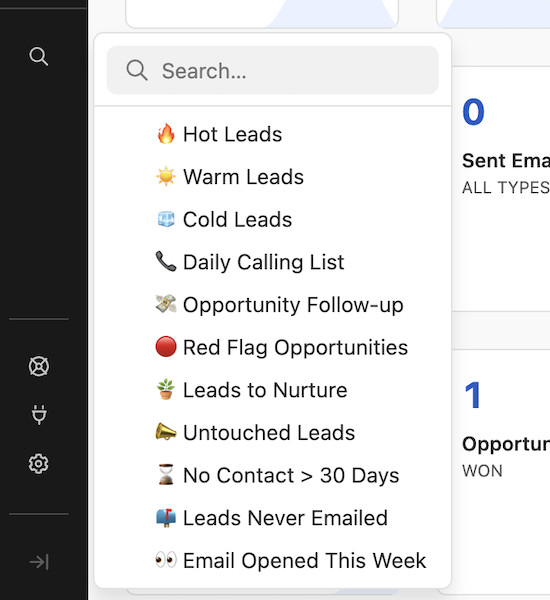
Close CRM Features
Here’s a closer look at the most important features in Close.
1. Built-In Calling, Email, and SMS
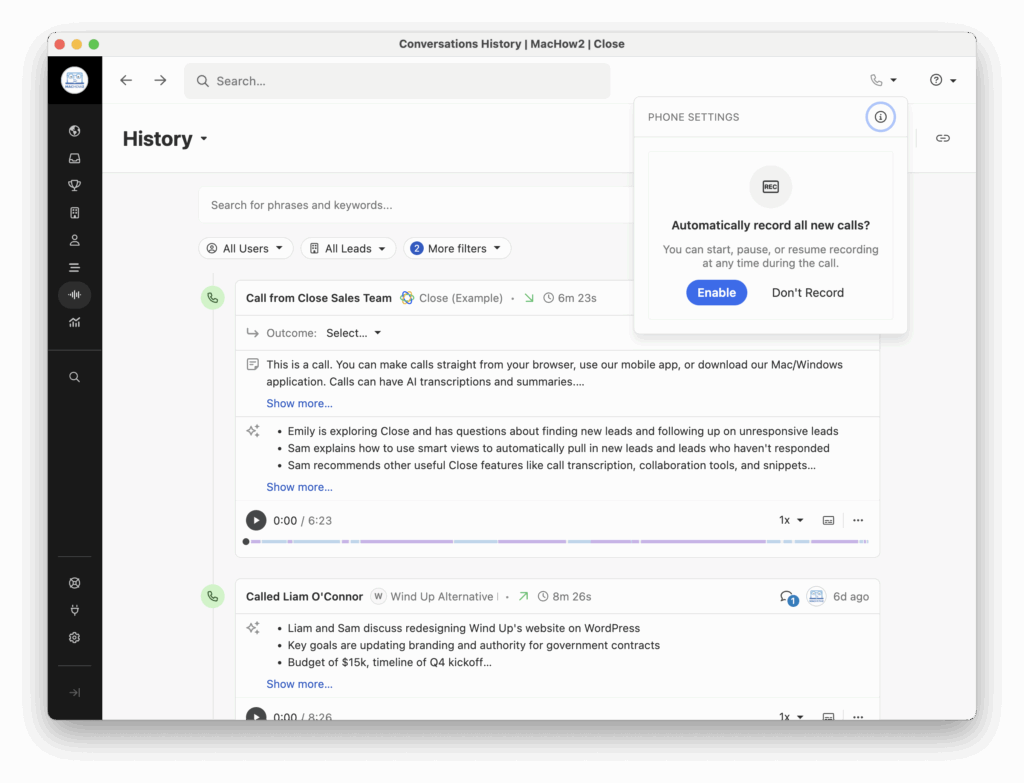
My favorite feature of Close are its communication tools. Reps can call, email, and text directly from Close, and every moment of contact is logged automatically. That means no more copy-pasting call notes or missing follow-ups. Conversations are recorded if you allow Close to access your microphone, with useful AI generated transcripts of calls avoiding the need for using separate dictation software.
2. Pipelines and Lead Management
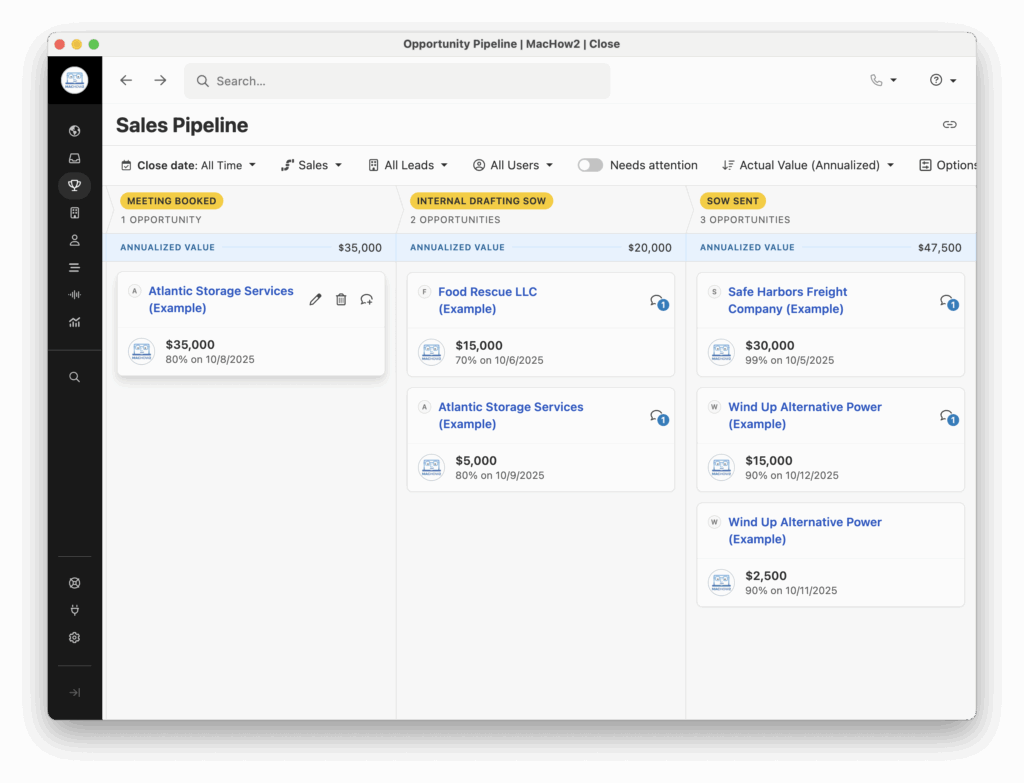
Close takes a different approach than visual-first CRMs like Pipedrive. Pipelines exist, but the product nudges you toward activity-driven selling. Smart Views let you filter leads by status, activity, or custom rules, so reps always know who to contact next.
3. Automations
On higher tiers, Close offers workflow automations: automatic task creation, lead routing, and follow-up sequences. If you’re scaling, this helps standardize processes across your team. It’s a shame many of these are higher tier features but its not uncommon to have to pay a premium for automation in CRM software.
4. Reporting and Analytics
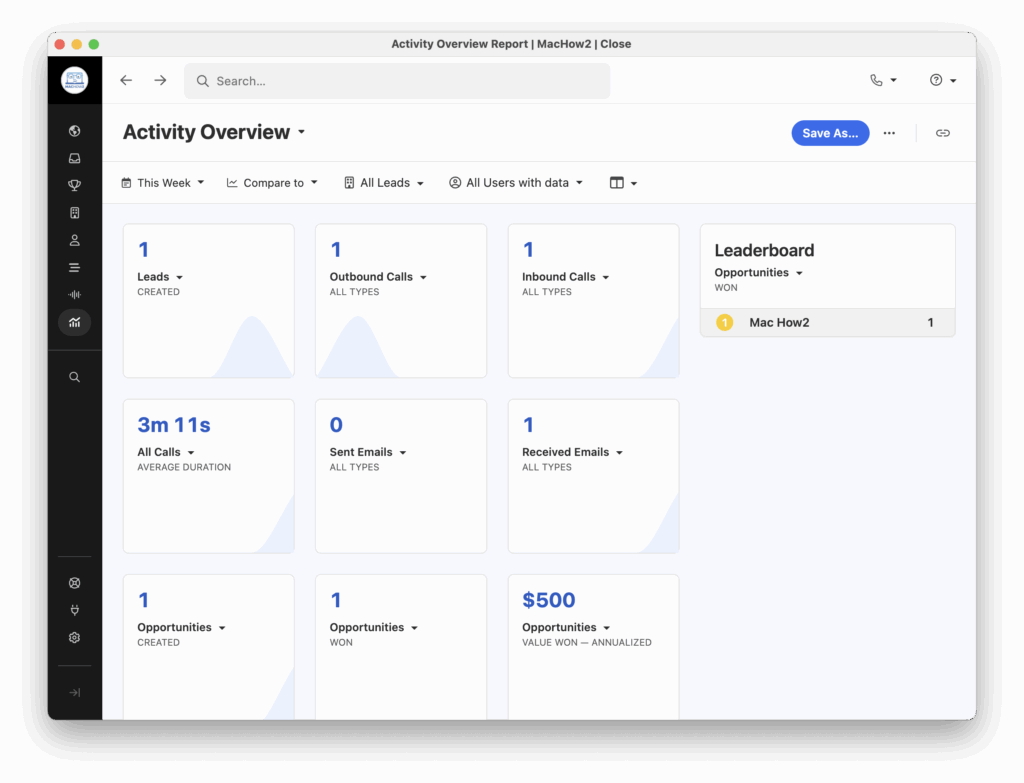
Reporting covers the essentials: pipeline health, sales activity, and rep performance. There’s a useful Activity Overview too which you can filter by time and view comparisons over set periods. For deep business intelligence however, you’ll probably want to connect Close to a BI tool or data warehouse.
5. Integrations and API
Like any good CRM, Close plays well with other apps. You can sync it with Gmail, plug in Calendly or Zoom, or connect via Zapier to just about any other tool in your stack. The API is well-documented if you want to create a custom connection.
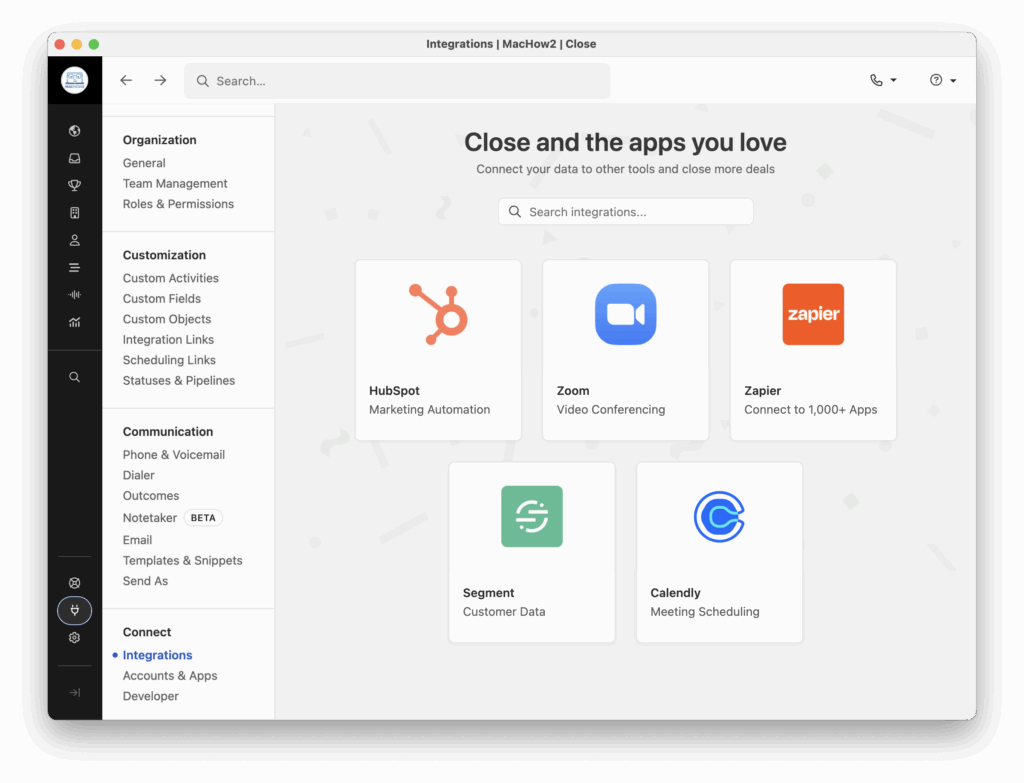
Pricing: Is Close Worth It?
The most recent edition to Close’s pricing plans is the Solo Plan designed for individuals which costs a very reasonable $9/month. However, it’s limited to just 10,000 leads and there’s no Pipeline guidance, follow-up reminders or customization possible.
Close’s team pricing starts at $35/user/month for the Essentials Plan, which already includes built-in calling and email and unlimited leads.
The Growth Plan ($99) and Scale Plan ($139) tiers add more automation, bulk email and advanced reporting.
It’s not the cheapest CRM out there, but it’s good value for teams that want integrated communications and the Solo Plan is great for freelancers.
Keep in mind that phone minutes and SMS costs may add up, depending on your outreach volume.
For solo founders or very small teams, free CRMs like HubSpot might make sense, but as soon as you’re serious about sales efficiency, Close justifies its price.
Security and Compliance
If your business is in Europe or handles sensitive data, security matters. Close complies with:
- SOC 2 Type II compliant.
- GDPR-friendly with data controls.
- Encryption at rest and in transit.
For industries with extra-tight regulations (like healthcare), you’ll still need to double-check whether Close meets sector-specific standards like HIPAA.
How Does Close Compare to Other CRMs?
- HubSpot: Better if you need marketing automation and inbound tools, but heavier and pricier at scale.
- Pipedrive: Great visual pipeline management, but Close edges it out on integrated communications.
- Daylite (Mac-only CRM): Fantastic for Apple ecosystem purists, but doesn’t have Close’s built-in calling or SMS.
CRM Comparison Table: Close vs HubSpot vs Pipedrive vs Daylite
| Platform / Mac compatibility | Native desktop app + web version works well on Mac. | Web + desktop/web-apps; works smoothly in browser. | Web + mobile; works fine on Mac via browser. | Designed exclusively for Mac, iPhone & iPad; works offline; Apple device integration. |
| Built-in calling / SMS | Yes, calling, email, SMS built-in and auto-logged. | Limited; add-ons or integrations required. | Calling via integrations depending on plan. | More focused on email and Apple Mail; limited built-in telephony. |
| Email & communication tracking | Excellent; logs all comms, sequences supported. | Very strong; includes email logging, automation, sequences. | Good; email integration and reminders. | Strong with Apple Mail; templates and contact history included. |
| Pipeline & lead management | Multiple pipelines, Smart Views, activity-first design. | Strong pipelines; more advanced on paid plans. | Very visual pipeline, intuitive drag-and-drop. | Built-in pipelines and opportunities; tailored for Apple users. |
| Automation & workflows | Follow-ups, lead routing, tasks; more advanced on higher tiers. | Powerful sales + marketing tools; strongest at scale. | Basic to mid-level automations; good for sales tracking. | Task reminders, project links; less automation than Close or HubSpot. |
| Reporting & analytics | Solid activity + pipeline reporting; external BI for deeper insights. | Strong dashboards; detailed marketing + sales reporting. | Decent reporting; focused on deals and pipeline progress. | Good reporting for small/medium teams; focuses on deals and opportunities. |
| Integrations & API | Gmail, Calendar, Zoom, Calendly, Zapier, API. | Huge ecosystem; marketing, sales, service apps. | Many integrations via marketplace. | Apple ecosystem integrations (Contacts, Mail, Calendar); fewer third-party options. |
| Pricing | Solo Plan $9/month. Team plans from ~$35/user/month; higher tiers add automation & reporting. | Free tier available; advanced features can get expensive. | Affordable tiers; good value for small sales teams. | Mid-tier pricing; fair for Mac-only SMBs. |
| Best for | SMB inside/outbound teams who want speed + comms in one place. | Businesses needing full sales + marketing suite. | Teams wanting visual pipeline management with affordability. | Mac/iOS-centric businesses needing offline access + Apple integration. |
| Drawbacks | Limited marketing features; automation capped on lower plans. | Costs rise quickly; some features locked to higher tiers. | Reporting less advanced; not for large/complex orgs. | Limited telephony; fewer integrations outside Apple ecosystem. |
Who Should Use Close?
Close is best for:
- SaaS startups and SMBs running outbound or inside sales teams.
- Remote sales teams who need fast, unified communication.
- Founders who want a no-nonsense CRM that keeps data tidy automatically.
It’s less ideal if:
- You’re running large enterprise-level sales operations.
- You rely heavily on marketing automation.
- You want deep forecasting or BI out of the box.
FAQ
Does Close work on Mac?
Yes, Close offers a native desktop app for Mac as well as a browser version.
Can I sync Gmail with Close?
Yes, Close integrates directly with Gmail (and other email providers), logging emails automatically.
Is Close secure for EU businesses?
Yes, Close is SOC 2 Type II compliant and GDPR-friendly, with strong encryption practices.
Is Close better than HubSpot?
If you want marketing + sales in one tool, HubSpot is stronger. If you just need sales communications and pipelines, Close is faster and simpler.


